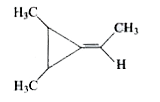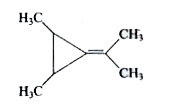Which of the following will not show geometrical isomerism?
[Co(ox)3]3−
[Co(en)2Cl2]Cl
[Cr(NH3)4Cl2]Cl
Both (b) and (c)
The correct Answer is:A
To determine which of the given compounds will not show geometrical isomerism, we need to analyze the structural features of each compound. Geometrical isomerism occurs when there is restricted rotation around a bond, typically in coordination complexes, leading to different spatial arrangements of ligands.
1. Understanding Geometrical Isomerism:
- Geometrical isomerism arises due to the different spatial arrangements of atoms or groups in a molecule that cannot freely rotate around a bond. This is commonly seen in octahedral and square planar complexes.
2. Identifying the Complexes:
- We need to look at the complexes provided in the question. For example, complexes like M(A)2(B)4 and M(AA)3 are common structures where geometrical isomerism can occur.
3. Analyzing the First Complex (M(A)2(B)4):
- In this structure, if we have two different types of ligands (A and B), we can arrange them in either a cis or trans configuration. Therefore, this complex can exhibit geometrical isomerism.
4. Analyzing the Second Complex (M(AA)3):
- Here, if we have a bidentate ligand (like oxalate, OX), it can occupy two coordination sites. Since all ligands are identical (AA), there is no possibility for cis or trans arrangements. Thus, this complex does not exhibit geometrical isomerism.
5. Analyzing Other Complexes:
- For complexes like CO(Cl)2(En)2, we can arrange the ligands in cis and trans configurations, allowing for geometrical isomerism.
- Similarly, for other octahedral complexes with different ligands, we can find arrangements that lead to geometrical isomers.
6. Conclusion:
- After analyzing all the complexes, the complex that does not show geometrical isomerism is COOx whole 3, 3-. This is due to the presence of identical bidentate ligands that do not allow for different spatial arrangements.
Final Answer:
The complex that will not show geometrical isomerism is COOx whole 3, 3-.
- Geometrical isomerism arises due to the different spatial arrangements of atoms or groups in a molecule that cannot freely rotate around a bond. This is commonly seen in octahedral and square planar complexes.
- We need to look at the complexes provided in the question. For example, complexes like M(A)2(B)4 and M(AA)3 are common structures where geometrical isomerism can occur.
- In this structure, if we have two different types of ligands (A and B), we can arrange them in either a cis or trans configuration. Therefore, this complex can exhibit geometrical isomerism.
- Here, if we have a bidentate ligand (like oxalate, OX), it can occupy two coordination sites. Since all ligands are identical (AA), there is no possibility for cis or trans arrangements. Thus, this complex does not exhibit geometrical isomerism.
- For complexes like CO(Cl)2(En)2, we can arrange the ligands in cis and trans configurations, allowing for geometrical isomerism.
- Similarly, for other octahedral complexes with different ligands, we can find arrangements that lead to geometrical isomers.
- After analyzing all the complexes, the complex that does not show geometrical isomerism is COOx whole 3, 3-. This is due to the presence of identical bidentate ligands that do not allow for different spatial arrangements.
The complex that will not show geometrical isomerism is COOx whole 3, 3-.
Similar Questions
Knowledge Check
Which of the following will not show optical isomerism ?
ACl−CH=C=CH−ClBBr−CH=C=CH−BrC D
D
Which of the following will not show optical isomerism as well as geometrical isomerism ?
A B
B C
C D
D
Which of the following cannot show geometrical isomerism
View SolutionWhich of the following will not show optical isomerism?
View SolutionWhich of the following can show geometrical isomerism?
(i) Propene (ii) But-1-ene (iii) But-2-ene (iv) Pent-2-ene
View SolutionOne among the following will not show geometrical isomerism
View SolutionWhich of the following will exhibit geometrical isomerism?
View SolutionWhich of the following can show geometrical isomerism.

View Solution